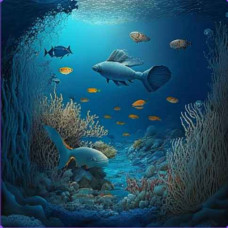From the Greek bénthos - depth.
The aggregate of organisms living on and in the substrate of marine and inland waters. In contrast to the benthos, organisms that live in the water column and are not attached to the bottom are called pelagic organisms (neuston, pleistone, plankton and necton). Benthic organisms are divided into animal (zoobenthos) and plant (phytobenthos). In zoobenthos we distinguish between animals that live on the bottom of a water body, animals that live in or on the bottom, animals that are mobile or sedentary, animals that are partially embedded in the bottom or attached to the bottom. Zoobenthos can be divided into carnivores (eating flesh), herbivores, detritivores (eating organic particles), etc. Many animals that live on the bottom of a water body are difficult to classify as pelagic or benthic and are referred to as: planktobenthos and nectobenthos. Benthic organisms are classified by size into large (macrobenthos), medium (mesobenthos) and small (microbenthos). The term meiobenthos is also used - small benthic organisms without bacteria.
In the oceans, zoobenthos are represented mainly by foraminifers, sponges, coelenterates, nemertines, polychaetes, sipunculids, bryozoans, brachiopods, molluscs, crustaceans, echinoderms, ascidians and fish. Most of the zoobenthos is restricted to shallow waters. On the littoral and in the upper sublittoral horizon, the mass of animal organisms in an area of 1 m2 can reach tens of kilograms (mainly molluscs). At depths up to 100-150 m, the benthic biomass amounts to hundreds and tens of grams; at 500-1000 m, the benthic biomass is sometimes also measured in grams, at deeper depths in fractions of grams, and at greater depths (abyssal) in milligrams. There is also a vertical zonation of distribution: molluscs and crustaceans predominate in the upper horizons, molluscs, polychaetes and echinoderms in the middle horizons, and polychaetes, crustaceans and echinoderms in the deeper horizons.
Some benthic animals cause damage. The most important of these are marine woodworms (Teredinidae). Many marine organisms settle in large numbers on the bottom of ships, reducing their speed.
A distinction is also made between the epibenthos, organisms that live on the surface layer of the bottom sediments, and the endofauna, organisms that live directly in the bottom sediments. The epibenthos can be either sessile or vagile.
The following types of benthic organisms are distinguished according to their mode of feeding:
Predators;
Suspension eaters;
Soil eaters;
Scrapers;
Filtrators.
Benthos
Tags: Benthos




